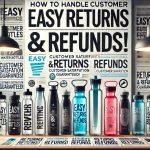In today’s marketplace, where consumers have a multitude of choices, trust is the cornerstone of a successful brand. For water bottle brands, where products often compete on factors like quality, design, sustainability, and price, customer testimonials can be a game-changer. These testimonials—whether in the form of written reviews, video endorsements, or social media posts—serve as powerful tools that provide social proof, build credibility, and influence purchasing decisions.
Customer testimonials are far more than just positive feedback; they offer potential buyers a glimpse into the real-world benefits of your product. This authenticity resonates with consumers, fostering trust and ultimately driving sales. In the competitive world of water bottles, where new brands constantly emerge, utilizing customer testimonials can be one of the most effective ways to differentiate your brand, build loyalty, and expand your reach.
The Role of Testimonials in Building Trust
Establishing Credibility
One of the primary functions of customer testimonials is to establish your brand’s credibility. In an age where online reviews and social media opinions heavily influence consumer choices, testimonials serve as a direct endorsement of your product’s quality and functionality. When potential customers see that others have had positive experiences with your water bottles, it reinforces the perception that your brand is trustworthy and reliable.
Customer testimonials create a sense of authenticity that is often hard to achieve through traditional advertising. Unlike marketing copy, which may feel promotional or scripted, testimonials reflect real experiences, making them more relatable and persuasive. This social proof has become crucial for online shoppers, who rely heavily on the opinions of previous buyers before making a purchase.
Enhancing Perceived Value
The perceived value of your water bottles can be significantly enhanced through the use of positive testimonials. Customers are more likely to justify spending on premium products when they see others vouch for their quality and effectiveness. For instance, if a testimonial highlights the durability, sustainability, or ergonomic design of your water bottle, potential buyers will associate those qualities with the value they’re receiving for their money.
Furthermore, if testimonials emphasize the emotional benefits—such as the convenience of carrying a water bottle that fits into a busy lifestyle or the eco-friendly features of a reusable bottle—these messages can resonate deeply with your target audience. By showcasing the value your product brings to their lives, you can justify premium pricing and elevate your brand’s position in the market.
Influencing Purchasing Decisions
Customer testimonials have a significant impact on purchasing decisions, as they help create a sense of community and belonging. People tend to trust the opinions of others, particularly when those opinions come from individuals they can relate to. For water bottle brands, testimonials can highlight the unique selling points of your product that matter most to your audience, whether that’s functionality, design, environmental impact, or health benefits.
Research shows that testimonials can increase conversion rates by up to 34%. Consumers are more likely to trust peer reviews and personal stories over traditional advertising, which often feels more sales-driven. Testimonials, when strategically placed on product pages, in marketing materials, and across social media, can help convert window-shoppers into buyers by providing the final push needed to make a purchase.
Types of Customer Testimonials
Written Testimonials
Written testimonials are the most common and versatile form of customer feedback. They can be used on your website, in email marketing campaigns, on social media, and in promotional materials. When collecting written testimonials, it’s essential to ensure that they are authentic, detailed, and specific to the customer’s experience.
Advantages of Written Testimonials
- Easy to Share: Written testimonials can be easily integrated into various platforms such as your website, product pages, and email newsletters.
- Flexibility: These testimonials can be formatted and edited for different uses, including blog posts, landing pages, and advertisements.
- Authenticity: When customers provide specific details about their experience, it adds to the credibility of the testimonial, making it more persuasive.
Best Practices for Written Testimonials
- Encourage Specificity: Rather than generic statements like “I love this water bottle,” ask customers to share specific details, such as what they like about the design, functionality, and sustainability of the product.
- Include Customer Names and Photos: If possible, include the customer’s name, photo, and any relevant details that make the testimonial feel more personal and genuine. This adds an extra layer of authenticity.
- Highlight Key Features: Encourage customers to talk about particular features that stand out, such as leak-proof lids, portability, or eco-friendly materials.
Video Testimonials
Video testimonials take the power of customer feedback to the next level. These dynamic and engaging pieces of content allow customers to speak directly to potential buyers, showing their enthusiasm and satisfaction. Video testimonials also offer a higher level of trust since they capture the authenticity of the customer’s experience in a more personal and relatable way.
Advantages of Video Testimonials
- Higher Engagement: Videos are more engaging and have higher retention rates than text-based content. Potential customers are more likely to watch a video than read through long-form testimonials.
- Emotional Connection: Video allows customers to convey emotion, tone, and body language, creating a stronger emotional connection with viewers.
- Credibility and Trust: Seeing real customers talk about their experience adds a layer of credibility and trust that written testimonials might not be able to achieve.
Best Practices for Video Testimonials
- Keep It Concise: Aim for a video length of 30 seconds to 2 minutes. This is enough time for customers to share their thoughts without losing the attention of viewers.
- Focus on Benefits: Encourage customers to explain not only why they love your water bottle but how it benefits them in their daily life. For example, “I take this bottle everywhere—it fits perfectly in my bag, and I love that it’s eco-friendly.”
- Authenticity Over Perfection: While video quality is important, it’s more important that the testimonial feels authentic. Avoid overly polished or scripted content.
Social Media Testimonials
Social media platforms provide a unique opportunity for customers to share their experiences in a public, interactive way. Whether it’s through Instagram posts, Twitter comments, Facebook reviews, or TikTok videos, social media testimonials give your brand visibility and authenticity on a wide scale.
Advantages of Social Media Testimonials
- Wider Reach: Social media testimonials have the potential to go viral, reaching not only your followers but also the followers of your customers.
- Engagement and Interaction: Social media testimonials allow for direct engagement, where you can comment, like, or share posts from happy customers, thereby building a sense of community.
- User-Generated Content: Social media testimonials create an opportunity for user-generated content (UGC), which can be repurposed for marketing campaigns, ads, and product pages.
Best Practices for Social Media Testimonials
- Create a Branded Hashtag: Encourage customers to use a specific hashtag when posting about your water bottles. This helps consolidate social proof and makes it easier to find and share relevant testimonials.
- Share Customer Posts: Regularly share customer-generated content on your own social media channels. This not only validates their experience but also builds community and loyalty.
- Incentivize Sharing: Offer incentives like discounts, giveaways, or entries into a contest to encourage customers to share their experiences on social media.
How to Collect Effective Customer Testimonials
Asking for Testimonials
One of the simplest ways to collect testimonials is by directly asking your customers for feedback. However, it’s important to approach the request in a way that makes it easy for customers to participate. Rather than sending a generic request, personalize your message and guide them on what type of feedback would be most helpful.
Best Practices for Asking
- Timing: Ask for testimonials at the right time—usually after a customer has received their product and had some time to use it. This ensures the feedback is based on real experience.
- Be Specific: Provide a few questions to guide the customer’s feedback. For example, “What do you love most about the design of our water bottle?” or “How has this bottle helped you in your daily routine?”
- Make It Easy: Provide a simple way for customers to submit their testimonials, whether it’s through a feedback form, email, or social media post.
Incentivizing Testimonials
While many customers are happy to leave testimonials out of goodwill, offering incentives can motivate more of your customer base to participate. Incentives can range from discounts on future purchases to entries into a contest or free gifts.
Best Practices for Incentivizing Testimonials
- Offer Meaningful Rewards: Make sure the reward is valuable enough to encourage participation. This could be a small discount, a free water bottle, or loyalty points that can be redeemed for future purchases.
- Make Rewards Conditional: To ensure that the testimonials are genuine, offer incentives only for detailed and thoughtful feedback, rather than generic or superficial comments.
- Respect Privacy: Ensure that customers are comfortable with the use of their testimonials and respect their privacy. If you plan to feature their testimonial publicly, ask for permission.
Using Automated Tools for Testimonial Collection
To streamline the process of collecting testimonials, many brands turn to automated review systems. These tools can send follow-up emails or SMS messages to customers after purchase, asking for feedback and making it easy for them to leave testimonials.
Benefits of Automated Tools
- Efficiency: Automation reduces the manual effort required to reach out to customers and collect testimonials.
- Timeliness: Automated systems can be set up to request testimonials shortly after a product is delivered, capturing feedback while the customer’s experience is still fresh.
- Scalability: As your brand grows, automated tools help ensure that you continue to collect feedback without increasing your workload.
Leveraging Testimonials Across Your Marketing Channels
On Your Website
Customer testimonials are most effective when they are integrated directly into your website. Product pages should feature reviews and testimonials prominently, especially those that highlight specific features or benefits of your water bottle. This reinforces the decision-making process for potential buyers.
Best Practices for Website Testimonials
- Dedicated Testimonial Page: Consider creating a dedicated page for customer stories, reviews, and testimonials, where new customers can browse through different experiences.
- Product Pages: Showcase reviews directly on product pages, as these are the most likely places where customers are evaluating whether to buy.
- Video Integration: If you have video testimonials, embed them on relevant product pages to further enhance the credibility of your water bottles.
In Email Campaigns
Testimonials can be a powerful addition to email marketing campaigns. Use them in newsletters or special promotional emails to provide social proof, especially when promoting new products or seasonal sales.
Best Practices for Email Testimonials
- Segmented Campaigns: Use testimonials that match the interests of specific customer segments. For example, highlight testimonials from eco-conscious customers when promoting a new sustainable water bottle.
- Customer-Generated Stories: Encourage customers to share their stories via email campaigns. This can increase engagement and build a sense of community.
In Social Media Advertising
Incorporate testimonials into paid social media ads to enhance credibility and increase conversions. Ads featuring real customer experiences can resonate more effectively than traditional ads, particularly when the testimonials align with the audience’s values and interests.
Best Practices for Social Media Ads
- Testimonial Carousel Ads: Use multiple testimonials in a carousel ad format to showcase a variety of customer experiences.
- Customer Story Highlights: Feature customer stories in Instagram or Facebook Stories to humanize your brand and make it more relatable.
Maximizing the Impact of Testimonials
Consistent Collection and Updates
To maintain the relevance and effectiveness of your testimonials, regularly update your collection of feedback. New customers and products should be represented, and testimonials should be rotated to avoid redundancy. This ensures that your testimonials remain fresh, diverse, and aligned with your current brand messaging.
Engaging with Customers
Engage with customers who leave testimonials by responding to their feedback, thanking them for their time, and sharing their stories on your social channels. This interaction builds a positive relationship with your customer base and encourages further participation.
Incorporating Testimonials into Your Brand Identity
As your brand grows, consider integrating testimonials into your overall brand identity. Feature customer stories on packaging, in advertisements, and on your website to establish a deeper connection with your audience. Consistent use of testimonials can humanize your brand and help it stand out in the crowded water bottle market.
Conclusion
Customer testimonials are an indispensable asset for any water bottle brand. They not only help build trust and credibility but also provide valuable insights into what makes your products resonate with consumers. By strategically collecting, leveraging, and promoting customer testimonials, water bottle brands can establish a strong brand presence, foster loyalty, and ultimately drive sales. Whether through written reviews, video endorsements, or social media posts, the power of customer testimonials can significantly impact your brand’s growth and success.







